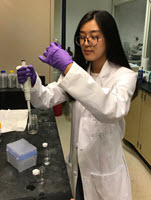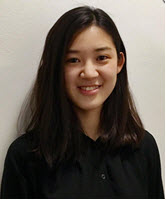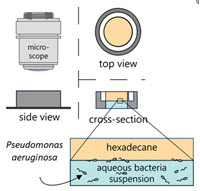
Oil-water interfaces, such as those formed by marine oil spills or natural ocean oil seeps, are teeming with bacterial activity. Some bacterial species in those interfaces form biofilms that help break up oil, which enhances biodegradation. The interfaces themselves can also significantly influence how bacteria behave, often trapping them or altering their natural movements.
Jiayi Deng tracks different bacteria movement patterns at the point where oil and water meet to explore key processes involved with interactions between oil spills and marine microorganisms. Information that she is uncovering about bacterial propulsion, structure, and interactions with interfaces and other bacteria can help researchers design bio-mimic microrobots and develop strategies to guide their motion towards oil spills for oil collection.
Jiayi is a Ph.D. student with the University of Pennsylvania’s Department of Chemical and Biomolecular Engineering and a GoMRI Scholar with the Dispersion Research on Oil: Physics and Plankton Studies III (DROPPS III) consortium.
Her Path
Jiayi’s parents are engineers who sparked her desire to solve real-world problems at a young age. She described chemical engineering as an art that uses fundamental ideas and physics to interpret natural processes and can be applied to all aspects of human life, including pharmaceuticals, biotechnology, and energy and environmental engineering. Jiayi completed a chemical engineering undergraduate degree at Dalian University of Technology and a chemical and biomolecular engineering master’s degree at the University of Pennsylvania.

As a master’s student, Jiayi learned about soft matter (such as liquids and colloids) while working with polymers in Dr. Daeyeon Lee’s Soft Materials Research and Technology lab. She later took a course taught by Dr. Kathleen Stebe, a co-principal investigator with the GoMRI-funded DROPPS consortium, that described how surface energy can dominate some interfacial phenomena and what that means for designing functional materials.
“I was fascinated by the complex structures formed on interfaces and how these phenomena can be explained using the physics and fundamental concepts of colloid and interface science,” said Jiayi. “I contacted Dr. Stebe and gained a great opportunity to join her GoMRI research into bacterial dynamics at the oil-water interface as a Ph.D. student.”
Her Work
Jiayi studies the swimming behavior of lab-cultured Pseudomonas aeruginosa (strain PAO1), a marine species that forms an elastic biofilm at the oil-water interface and consumes hydrocarbons. She conducts her experiments in a 1-centimeter cylinder with an aluminum bottom half and a Teflon top half that intersect in the middle, creating a planar interface. After adding bacteria suspended in an aqueous solution and then hexadecane to form an oil-water interface, she uses an upright bright-field microscope and a high-speed camera to observe the interfacial interactions and capture one-minute videos at 60 frames per second.

Next, Jiayi interprets the bacteria’s position in each frame using a multiple particle tracking algorithm to determine their motion. She observes several metrics that provide insight into bacterial swim behavior: swim speed, the curvature of their circular path, how fast they complete a circular path, time spent moving forward and backward, and the dynamics of different bacteria types. So far, she has observed four distinct trajectories affecting how bacteria move: (1) movement driven by collision, (2) swimming in curly paths, (3) swimming in pirouette motions, and (4) interactions with other bacteria that enter and exit the interface freely.
Jiayi developed a method to analyze hydrodynamic interactions between the bacteria and the interface. She places passive tracer particles at the interface before adding hexadecane and then measures the correlated motion between bacteria and passive tracers to determine how active bacteria displace tracer particles. “This displacement field shows how bacteria interact with passive colloids (inactive suspensions of particles) and small molecules,” explained Jiayi. “By measuring their correlated motions, we can directly measure the hydrodynamic flow field around the swimming bacteria at small time scales.”

Using this method, Jiayi found that swimming microbes greatly enhance interfacial mixing by a factor of three. She observed two main dynamics: (1) bacteria that are trapped at the interface perform curly, diffusive, and pirouette motions and (2) bacteria that freely enter and exit the interface closely interact with the trapped bacteria. “The persistent curvilinear trajectories (i.e., curly or pirouette trajectories) of interface-trapped particles differ significantly from motions in the bulk. Interface trapping makes these motions quite stable, creating a convective flow around the swimmers,” explained Jiayi. “These microswimmers can generate flows in both the interface and the surrounding phases, breaking the oil spill into smaller droplets that are easier for microbes near the interface to digest.”
Her Learning
Dr. Stebe helped Jiayi understand the value of being passionate and thinking creatively beyond the original research goal, which typically becomes broader as an experiment develops. Jiayi and her colleagues discovered additional bacteria behaviors at the interface related to their adhesion state and hydrodynamical interactions with the oil-water interfaces. “We were excited by their different modes of motion and studied these motions using hydrodynamics and interfacial science, but we also wanted to explore their applications on interfacial transport,” said Jiayi. “Interacting with people from other fields and breaking the patterns and traditional ways of thinking helped us reach more creative solutions.”
Her Future
Jiayi hopes to find a post-doctoral position in academia where she can continue conducting chemical or biological engineering research.
The GoMRI community embraces bright and dedicated students like Jiayi Deng and their important contributions. The GoMRI Scholars Program recognizes graduate students whose work focuses on GoMRI-funded projects and builds community for the next generation of ocean science professionals. Visit the DROPPS website to learn more about their work.
By Stephanie Ellis and Nilde Maggie Dannreuther. Contact sellis@ngi.msstate.edu for questions or comments.
************
The Gulf of Mexico Research Initiative (GoMRI) is a 10-year independent research program established to study the effect, and the potential associated impact, of hydrocarbon releases on the environment and public health, as well as to develop improved spill mitigation, oil detection, characterization and remediation technologies. An independent and academic 20-member Research Board makes the funding and research direction decisions to ensure the intellectual quality, effectiveness and academic independence of the GoMRI research. All research data, findings and publications will be made publicly available. The program was established through a $500 million financial commitment from BP. For more information, visit https://gulfresearchinitiative.org/.
© Copyright 2010-2019 Gulf of Mexico Research Initiative (GoMRI) – All Rights Reserved. Redistribution is encouraged with acknowledgement to the Gulf of Mexico Research Initiative (GoMRI). Please credit images and/or videos as done in each article. Questions? Contact web-content editor Nilde “Maggie” Dannreuther, Northern Gulf Institute, Mississippi State University (maggied@ngi.msstate.edu).
